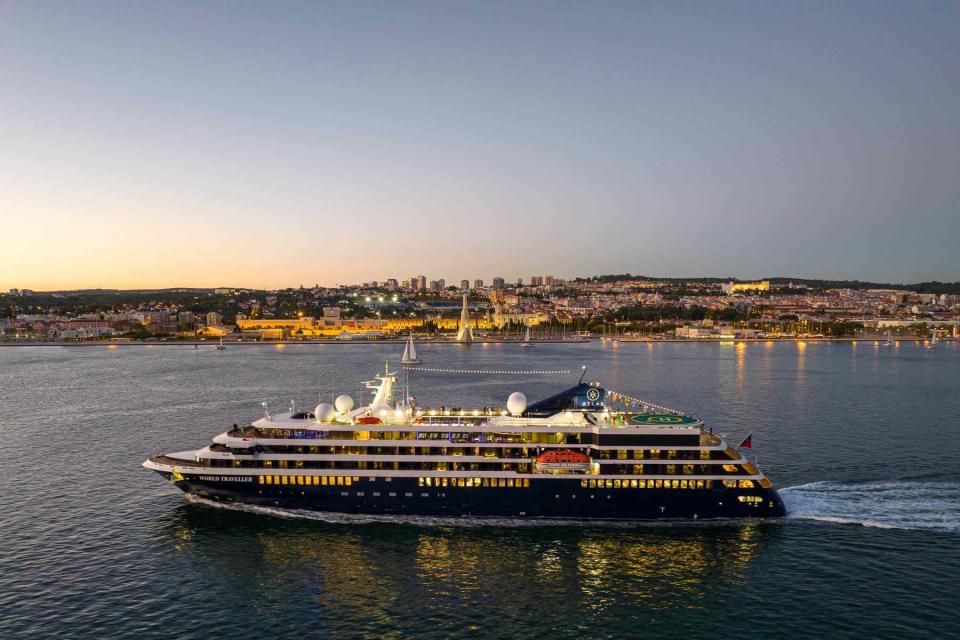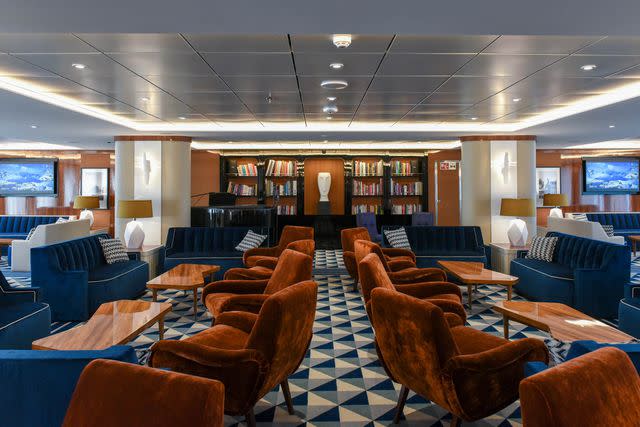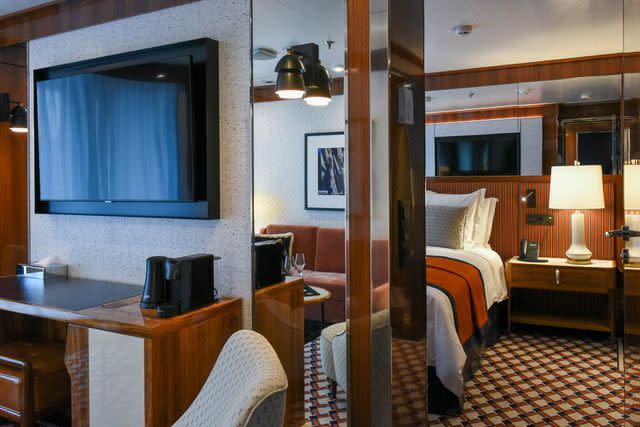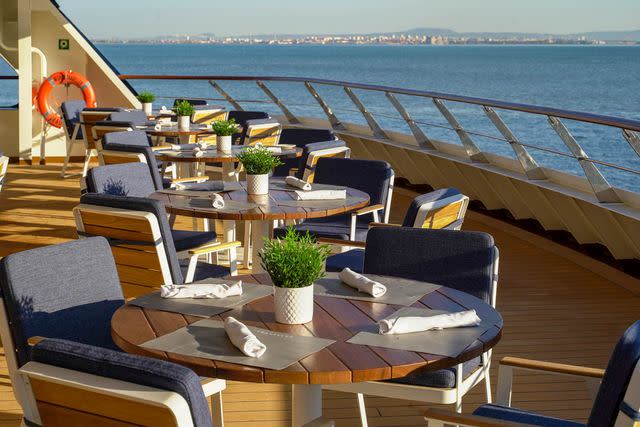This New Cruise Line Just Launched a Ship in Antarctica — Here's What It's Like on Board
Atlas Ocean Voyages, which launched in 2021, now has a second ship: World Traveller.

Courtesy of Atlas Ocean Voyages
"It's my third trip to Antarctica," I heard one passenger say to another as we touched down in Ushuaia, Argentina, where we'd board Atlas Ocean Voyages' brand-new ship World Traveller.
"Really?" the second passenger asked.
"Of course not," laughed the first.
I chuckled to myself. It was, in fact, my third trip to Antarctica. Like the vast majority of my fellow guests, it was our vessel's very first voyage to the White Continent. It was also the first trip to Antarctica for Atlas Ocean Voyages president and CEO James Rodriguez, who joined the cruise line in August after two decades with Oceania Cruises.
As a repeat Antarctic visitor — and as a travel writer developing a focus on polar expeditions — my mission on board was not to check off my seventh continent, but to see what both our ship, World Traveller, and our cruise line, the year-old Atlas Ocean Voyages, were all about.
The Ship

Courtesy of Atlas Ocean Voyages
World Traveller is the second ship in the Atlas Ocean Voyage fleet, following World Navigator, which launched in 2021. The ships are, in a way, fraternal twins — they are both custom-built, Ice Class 1B-certified ships with identical layouts but entirely different design schemes. While World Navigator takes on an art deco-meets-midcentury glam, World Traveller is all about la dolce vita yachting, per the cruise line, and, in my opinion, classic New England nautical sophistication. The entire ship is clad in wood paneling and bedecked with blue-and-white textiles and black-and-white photographs of vintage ships. It's all comfortable, understated luxury, and a divine place to spend two days at sea when crossing the Drake Passage.
As for amenities, there are all your standard players: a lecture hall, a main-deck bar and lounge, an all-window observation lounge on the top deck called The Dome that doubles as an entertainment venue, a running track, and a L'Occitane spa with treatment rooms, a sauna, and a relaxation room (OK, that might not be so standard). There's also an outdoor pool and hot tub. While I wasn't brave enough to go for a swim, I did take a dip in the hot tub during a light snowfall, with icebergs to both port and starboard.

Courtesy of Atlas Ocean Voyages
For dining, there's one main restaurant, which serves a buffet breakfast with an à la carte option, a buffet lunch, and a blend of buffet and seated dinners, with the latter being more popular. There is an outdoor grill, but it's understandably closed on polar itineraries. (World Traveller, as the name suggests, will sail all around the world, including to destinations with much milder climates.) We should note that this is an all-inclusive cruise, so there is no additional charge for meals and house drinks, including wine and cocktails.
My absolute favorite feature on board, however, was the grab-and-go café Paula's Pantry, where you could order both hot and cold beverages and pick up light bites (yogurts, paninis, salads). My favorite snack was the house-made granola bars. Most expedition ships adhere to a standard three meals per day, plus occasional snacks at tea time or happy hour, so grab-and-go is a true luxury. "[Paula's Pantry] is the best thing about this ship," remarked naturalist Jean-Roch de Susanne, an Antarctic veteran.
All in, the ship is an extraordinary environment to come back to after scrambling up a snowy ridge next to waddling (or tobogganing) chinstrap penguins, kayaking next to a curious young humpback whale, or getting splashed in the face with icy salt water as a gale picks up during your scenic Zodiac cruise — all things that happened during our voyage. (At least there's always a hot drink waiting for you in the mudroom upon your return.)
The Excursions
There are very strict rules about excursions in Antarctica, issued by the International Association of Antarctica Tour Operators (IAATO), which are designed to protect the natural environment. Only 100 passengers from a ship can be on land at any given time, and ships that carry more than 200 passengers are limited to specific landing sites that can handle larger capacities. And ships that carry more than 500 passengers can't do landings at all. Fortunately, World Traveller carries a maximum of 184 passengers in Antarctica — and on our sailing, we had exactly 100, which meant that we could all get off the ship at once.
To lead excursions, Atlas Ocean Voyages has recruited a blended team of both Antarctic veterans and Antarctic first-timers who have honed their skills guiding in other regions of the world, such as the coasts of the Pacific Northwest or the mountains and salt flats of Bolivia. Our expedition staff was led by Jonathan Zaccaria, who not only has experience on Antarctic ships, but also at land-based research stations. He has worked at both the Dumont d'Urville Station near the emperor penguin colony made famous by the documentary The March of the Penguins, as well as the Concordia Research Station in one of the most remote locations on the planet: Antarctica's Dome C.
In Antarctica, there are three main types of excursions: landings, Zodiac cruises, and water sports. And on World Traveller, we experienced them all. Landings often require a bit of athleticism, whether that's hiking through deep snow or across uneven rocks, or hoisting yourself into the Zodiac as the frigid sea rushes up to your knees. But they also afford you up-close and personal moments with wildlife, particularly penguins, sea birds, and seals. When conditions aren't ideal for a landing, there's often the option of a Zodiac cruise, in which you dart around icebergs and along shorelines to explore without putting your feet on terra firma. And finally, there are water sports, like kayaking and stand-up paddleboarding, when conditions allow.
As is standard with expedition travel, a schedule is never set in stone. Everything depends on the conditions of the sea, the air, and the land — and many times, the expedition leader and captain won't know those conditions until they arrive at a given destination. So flexibility is the name of the game. Every evening at a nightly recap in the lecture hall, Zaccaria would lay out for us potential plans for the following day. I'd say about half of them went off without a hitch, while the other half were Plan Bs or Cs or Ds. Because the expedition staff and the crew are so nimble, it's pretty easy for guests to roll with the changes, though it does sometimes mean early-morning PA announcements advising guests of the schedule shifts.
Expedition travel can be very overwhelming, and no matter how much research you do, it's not easy to prepare yourself for the experience. "I've been selling this voyage as an expedition, but to actually experience it really puts it into perspective," Rodriguez told Travel + Leisure. "You're waking up, going to these briefings that are explaining to you the weather conditions or what you may see out there, and taking safety into consideration, then putting on all the gear and getting ready to actually go out. There's an element of uncertainty — you don't know what you're going to see. And that's exciting, but a little bit surprising."
The Onboard Activities
As is standard on every expedition, lectures by the naturalists help immerse guests in the unique environment around them. On our voyage, they ranged from talks about the seabirds we saw around the ship on the Drake Passage to the geopolitical complexities of the Antarctic Treaty. The majority of the lectures take place during sea days, but I appreciated that Atlas Ocean Voyages fit a few in during our time in Antarctica, too. Plus, in the evenings, Zaccaria organized screenings of documentaries every other night — including one that he filmed during his time at Dumont D'Urville.
Those educational components, however, were balanced with classic luxury cruise activities, such as afternoon tea in The Dome, piano music at cocktail hour, and evening musical performances by cruise director Michael Shapiro. And as we were on the inaugural Antarctic voyage, we had a special guest on board, singer Asijah Pickett, to provide additional entertainment. Between the two, plus our pianist Chase Chandler, we were regaled with soul, Broadway, pop, and even opera on select evenings throughout our voyage.
I'll admit that I'm not always a fan of traditional cruise activities in Antarctica, because for me, the breathtaking landscapes, inquisitive wildlife, and overwhelming sense of nature's grandeur are the primary reason I keep returning. That said, when there's downtime on the ship — in the event of bad weather that cancels or shortens excursions, for instance, which happened several times during our voyage — I appreciated having more to do than read a book in the lounge or take a nap in my cabin. Plus, I recognize not everyone has my precise taste when it comes to polar expeditions, and some passengers might pass on an excursion in favor of relaxing at the spa. (I, too, love a good spa treatment, but I scheduled mine during our sea days on the Drake so that I wouldn't miss an excursion.)
The balance of expedition and traditional cruising is where Atlas Ocean Voyages absolutely hits the mark, and it's the main reason the cruise line stands out to me. My deep desire for education was perfectly sated — as was my desire to dance (or, rather, bop about in my chair, cocktail in hand) to Shapiro's rousing rendition of Copacabana.
The Cruise Line

Courtesy of Atlas Ocean Voyages
The cruise industry is an intriguing ecosystem, where there's a healthy blend of first-time cruisers, casual cruisers, and die-hard cruisers who sail multiple times per year. In that latter group, loyalty is everything. I've been on river cruises with guests who have sailed with their line of choice more than 50 times. So when it comes to launching a new cruise line, finding an audience is a tough task. Lucky for Atlas Ocean Voyages, which just launched in 2021, Rodriguez is no stranger to that challenge. He was with Oceania from the start, so he knows all about the importance of developing a brand identity.
"This was a brand that was conceived and created in a pre-pandemic world," said Rodriguez. "So what I did when I came in, having the benefit of hindsight, is said, 'Let's look at this in a post-pandemic world, where people are really wanting to reconnect with the world that they left.'"
Originally, Atlas Ocean Voyages was branded as an ultra-luxury cruise line with adventurous, off-the-beaten-path itineraries. But Rodriguez notes that in the current travel climate, people aren't necessarily looking for those kinds of trips. So, he's rejiggered the itineraries to focus more on the familiar with a few surprises thrown in. "I tried to mix in some of the marquee ports, like the Romes and the Barcelonas and Ibizas that Americans know about and have been to, with yacht-style ports in places they've never been to before," says Rodriguez.
That said, World Traveller and World Navigator were designed with polar destinations in mind, so Antarctica will still be on the docket. Traveller will cruise Antarctica until March 2023 when it heads to the Mediterranean.
So where does Atlas Ocean Voyages sit within the rapidly expanding field of Antarctic cruising? In my own limited experience in Antarctica, plus what I've heard from expedition staff across the industry, polar expedition ships often skew more toward hardcore expedition or more toward traditional luxury cruising. Atlas Ocean Voyages has a surprising balance of both, where I felt completely satisfied in terms of education and expedition, but also in terms of a luxury shipboard experience, from amenities to entertainment.
"There were a lot of guests where either the husband wanted to come and do this, but the wife was reluctant, or the wife really wanted to do it, but the husband was reluctant," said Rodriguez of our voyage. "I think we're that perfect product to offer experiences for both."
Rates for a nine-night voyage on World Traveller start from $7,999 per person, and you can book your cruise here.
For more Travel & Leisure news, make sure to sign up for our newsletter!
Read the original article on Travel & Leisure.


